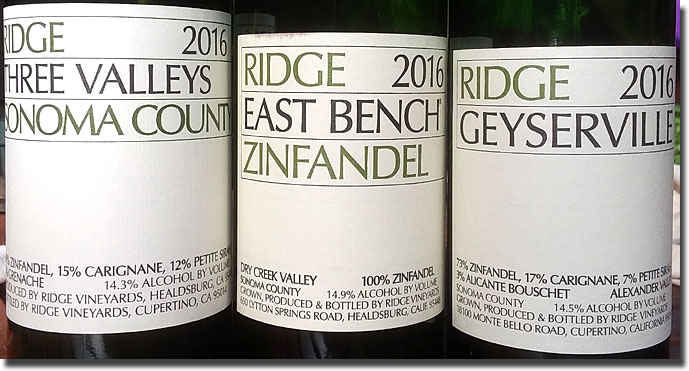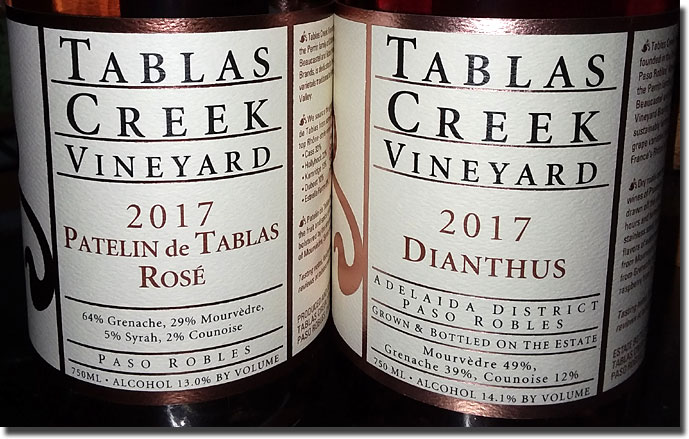Archive for the Tasting Notes from the Underground Category
Recent Wines
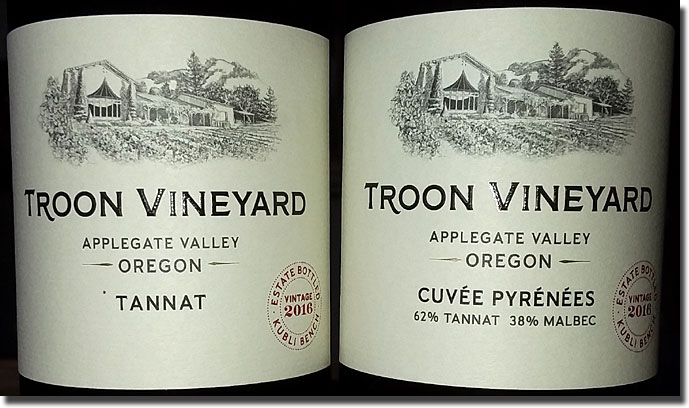 These four reds were submitted for review by one of our favorite Oregon wineries, Troon Vineyard, which recently received Demeter Biodynamic® certification. (Click on images to enlarge.)
These four reds were submitted for review by one of our favorite Oregon wineries, Troon Vineyard, which recently received Demeter Biodynamic® certification. (Click on images to enlarge.)
2016 Troon Vineyard Estate Tannat, Kubli Bench, Applegate Valley, 14% alc., $40.00: A very satisfying red, showing deep, dark color and spicy black fruit aromas. Rich and intense on the palate, with no spoofy frills, just earthy black currant and blackberry flavors. Full bodied and well-structured for several years in the cellar, yet drinking quite well already. Find this wine
2016 Troon Vineyard, Cuvêe Pyrénées, Kubli Bench, Applegate Valley, 63% Tannat, 39% Malbec co-ferment, 13.5% alc., $65.00: Clean dark garnet color; not quite as effusive on the nose as the Malbec, but still generous, with a rich black currant/berry nose. Earthy and fairly big in the mouth, with flavors that follow through on the promise of the bouquet. Plenty of structure here for several years of development, but more than approachable now, especially with some air and grilled red meat. The earth and fruit strike a nice balance, and set the tone for the wine’s personality. 18 months in mature oak. Find this wine
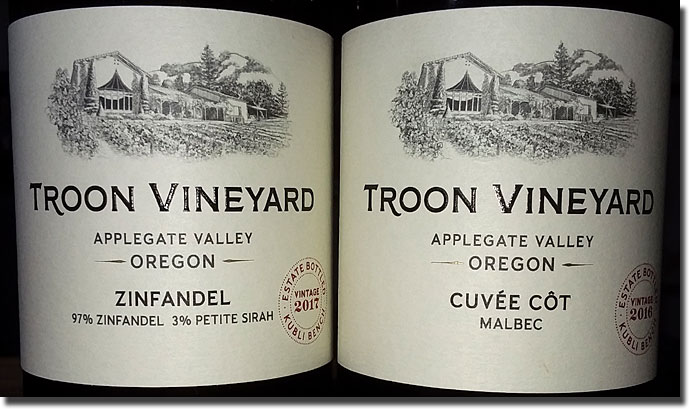 2016 Troon Vineyard, Cuvêe Côt, Estate Malbec, Kubli Bench, Applegate Valley, 13.4%, $40.00: Deep and dark in color; effusive ripe black currant and blackberry aromatics, shaded with some subtle earth and an ever-so-slight hint of the barnyard. Flavors echo and expand so nicely on a full bodied frame, with good structure and nice length. Some nuances imparted by the mature oak add to, rather than detract from the appeal. I like this much better than many of the Argentine specimens we’ve had, which tend to accentuate that “coffee and toast” character that comes from the barrel char that seems to be preferred there. Excellent now, and will improve for at least 3-5 years in the cellar. 18 months in mature oak. Find this wine
2016 Troon Vineyard, Cuvêe Côt, Estate Malbec, Kubli Bench, Applegate Valley, 13.4%, $40.00: Deep and dark in color; effusive ripe black currant and blackberry aromatics, shaded with some subtle earth and an ever-so-slight hint of the barnyard. Flavors echo and expand so nicely on a full bodied frame, with good structure and nice length. Some nuances imparted by the mature oak add to, rather than detract from the appeal. I like this much better than many of the Argentine specimens we’ve had, which tend to accentuate that “coffee and toast” character that comes from the barrel char that seems to be preferred there. Excellent now, and will improve for at least 3-5 years in the cellar. 18 months in mature oak. Find this wine
2017 Troon Vineyard, Estate Zinfandel, Kubli Bench Applegate Valley, Co-fermented with 3% Petite Sirah, 13.6% alc., $25.00: Kim expresses her enthusiasm for this from the very first sip, and I agree completely. Clean and dark in color, with a rather un-Zin-like nose that doesn’t entirely reflect the depth of fruit here. More old school in style, and very appealing in that regard; not too fruit forward, and nicely earthy, with subtly herbaceous undertones that grace the black cherry and red beet character. Pretty much ready to go right now, yet structured for at least a few years in the cellar. Yum! 12 months in mature oak. Find this wine
Reporting from Day-twah,
Bastardo
A Fine QPR Pinot Blanc
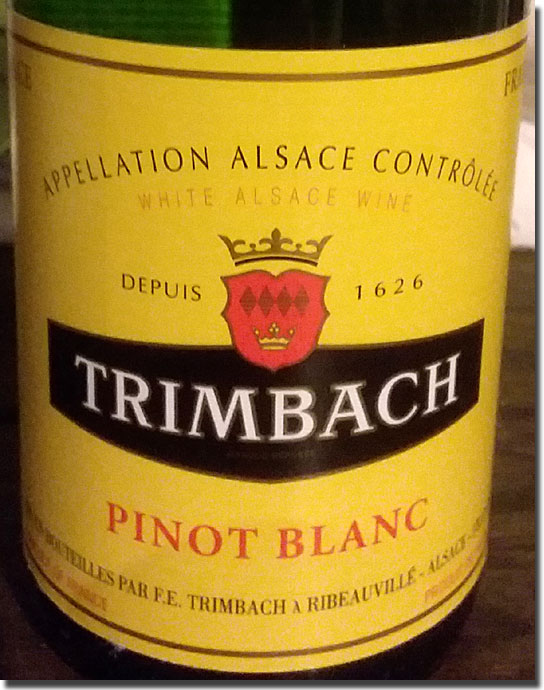 I’ve developed a taste for good Pinot Blanc over the last decade or so, due largely to the wonderful bottlings from Island View Vineyard (Old Mission Peninsula) produced by Left Foot Charley up in Traverse City. Before then, I thought of the Blanc as a rather bland, also-ran white that was less impressive than its cousin, Pinot Gris. So it took a Michigan version of a wine that is perhaps most often associated with Alsace to show me what is possible from this grape.
I’ve developed a taste for good Pinot Blanc over the last decade or so, due largely to the wonderful bottlings from Island View Vineyard (Old Mission Peninsula) produced by Left Foot Charley up in Traverse City. Before then, I thought of the Blanc as a rather bland, also-ran white that was less impressive than its cousin, Pinot Gris. So it took a Michigan version of a wine that is perhaps most often associated with Alsace to show me what is possible from this grape.
I’ve tried some other Pinot Blancs out of curiosity since then to see if I could find anything else as good, or close to as good, as the Island View, and did find a pair from Alsace that were delightful (along with one that fell far short of those two, noted in the same report). Another northern Michigan bottling made from young vines some years back showed lots of promise, and those vines are probably producing excellent fruit right about now, but I haven’t had the opportunity to taste and find out. Frankly, there just isn’t a lot of this stuff out there in this market, which is why I was so pleasantly surprised and intrigued when I found this one at our friendly neighborhood Costco some weeks ago.
2016 Trimbach Pinot Blanc Alsace, 13% alc., $13.96: Full disclosure: I’m sipping on another one of these as I file this report, and quite enjoying it whilst I do. I like everything about it, from the easy-to-open Stelvin enclosure, to the satisfying, mineral-laced finish. In between, there’s a cleanly colored, nicely ripe and round glass of wine in the gravelly green apple and lime spectrum that delivers more intensity of flavor that I had expected the first time I tried it. It has good weight and the requisite acidity to move everything along nicely and complement a variety of foods, starting with critters you pull out of the water. This would do equally well with some pan seared Michigan trout or a nice smoked, grilled chicken on the Weber. Tasted five times with consistent results!
I’ve had a number of wines from Trimbach’s “Classics” lineup over several decades, and while they’ve always been more than serviceable, I’m hard-pressed to remember one that I went back for again and again, like I have with this one. It offers solid QPR (quality-price-ratio), I like it a lot, and I’ll be going back for more. Soon. Find this wine
Imported by Esprit Du Vin, Boca Raton, FL
Reporting from Day-twah,
Bastardo
Red Wings and Red Rhones 2018
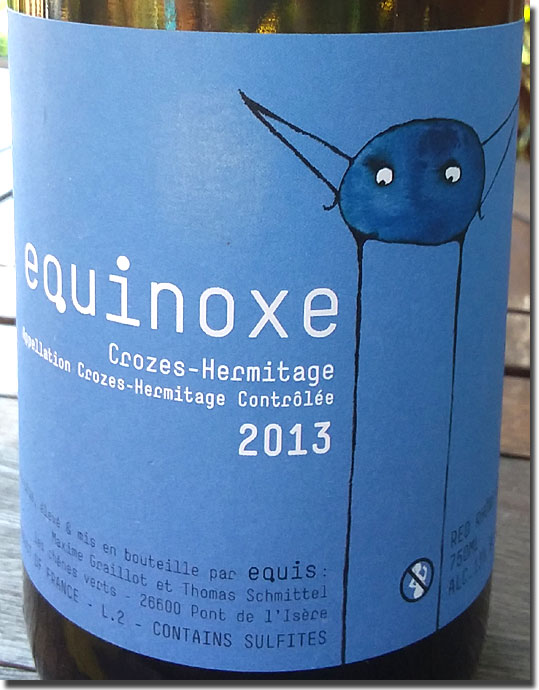 The glory days of the Detroit Red Wings are long gone. The team that made the NHL playoffs for an amazing 25 years in a row has not seen post-season action in the last two campaigns, and after to a brutal 0-6-2 start in 2018-19, has rebounded to be playing .500 hockey as of this writing. No one is picking them to make post-season play, but at least they’re not “the Dead Wings” of old, and who’s to say that this mix of promising youngsters and seasoned veterans can’t overachieve and surprise the pundits.
The glory days of the Detroit Red Wings are long gone. The team that made the NHL playoffs for an amazing 25 years in a row has not seen post-season action in the last two campaigns, and after to a brutal 0-6-2 start in 2018-19, has rebounded to be playing .500 hockey as of this writing. No one is picking them to make post-season play, but at least they’re not “the Dead Wings” of old, and who’s to say that this mix of promising youngsters and seasoned veterans can’t overachieve and surprise the pundits.
And so, I thought it would be fun to tune into an early season game and relive some of the old “Red Wings and Red Rhones” days, complete with a fine Crozes-Hermitage, just like those days back in ‘97 when we got that tradition started here at Gang Central. Past vintages of this one, made by Maxime Graillot, son of the legendary Alain Graillot, have delivered all the goods, so I was interested in tasting what a more recent model has to offer.
2013 Domaine des Lises Crozes-Hermitage Équinoxe Maxime Graillot, 13% alc., $21.99: Deep and dark in color, and a little funky on the nose in a way that we like, with some barnyard over black plum, iodine and underbrush/garrigue. Very earthy on the palate (again, that’s a big plus in our notebook), with flavors that follow through enthusiastically on the promise of the nose. A substantial wine, well structured, as you’d expect, with plenty of tannins yet to resolve, but still approachable, especially with extended air. An hour in a decanter before pouring glasses of this is not a bad idea at all, so you can drink it now or tuck it away in the cellar for 7-10 years. This offers very good value for the price listed above, and we bought ours at Ferndale’s Western Market. Find this wine
Imported by Europvin U.S.A, Van Nuys, CA
Yes, the Red Wing’s glory days are gone, and they lost the game I watched whilst enjoying this big red. The only time you’ll see the likes of Yzerman, Federov, Shanahan, Lidstrom, Datsuk or Zetterberg will be in old-timers games. It’s kind of sad, even for a recovering sports junkie such as myself, but I’m not losing any sleep over it. We’ll have to wait to see what the future brings, with both the wine and the only team I still follow.
Reporting from Day-twah,
Bastardo
My Kind of Merlot
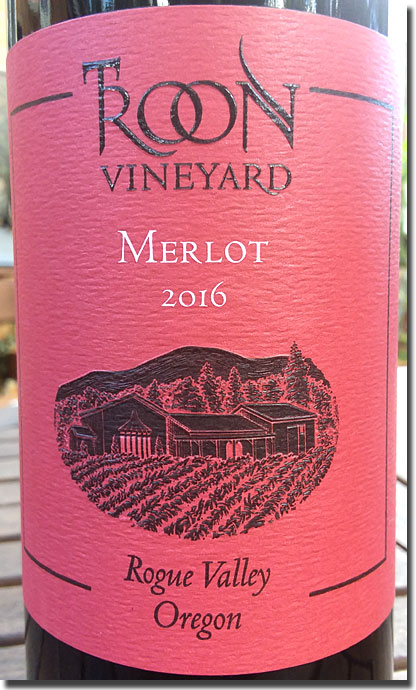 I was quite pleasantly surprised to notice last week that wines from Troon Vineyard have finally made their way into the Detroit market. I was perusing the shelves of (where else) Ferndale’s Western Market, and found placements of Troon’s 2016 Whole Grape Ferment (Orange) Riesling, which we reviewed a while back, and the bottle noted below. We’ve tried and enjoyed quite a few different things from this rising star from southern Oregon over the past couple of years, thanks to General Manager Craig Camp’s inclusion of the Gang on Troon’s reviewers list, so, given that, I was only too happy to fork over the bucks to give this one a try.
I was quite pleasantly surprised to notice last week that wines from Troon Vineyard have finally made their way into the Detroit market. I was perusing the shelves of (where else) Ferndale’s Western Market, and found placements of Troon’s 2016 Whole Grape Ferment (Orange) Riesling, which we reviewed a while back, and the bottle noted below. We’ve tried and enjoyed quite a few different things from this rising star from southern Oregon over the past couple of years, thanks to General Manager Craig Camp’s inclusion of the Gang on Troon’s reviewers list, so, given that, I was only too happy to fork over the bucks to give this one a try.
2016 Troon Vineyard Merlot Rogue Valley, 13.8% alc, $19.99: We like everything about this wine, starting with the twist-off Stelvin enclosure. (Kim just loves the sound these make when you crack them open, and neither of us are cork snobs.) It shows a clean, dark color, and exudes an earthy black currant and blackberry nose, shaded with subtle herbaceous notes that add to, rather than detract from the appeal. These impressions echo and explode on the palate; the earth and herb play off the attractive fruit very nicely, and there’s not a hint of oak to be found. Yay! Full bodied without being heavy, and while it’s structured for at least 5 years in the cellar, it’s more than approachable already. This shows a sense of place, and will never be mistaken for one of the cookie cutter models coming out of Sonapanoma and surrounding environs, and that’s just the way we like it. Frankly, I went back a few days after trying this and brought more, because it offers a lot for the price. It’s an obvious red meat kind o’ wine, and check out Troon’s Facebook page for lots of food pairing ideas for this and many others of Troon’s bottlings. Find this wine
Reporting from Day-twah,
Bastardo
Pink Drinks Red
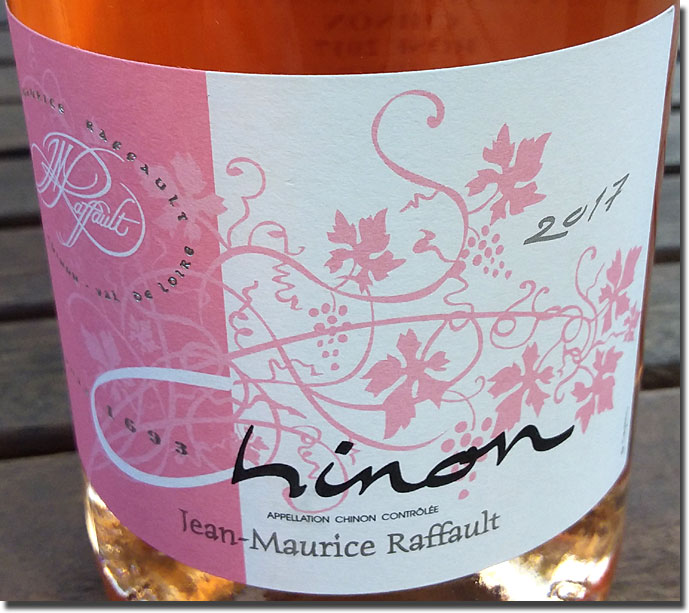 There are rosés and then there are rosés. Most often what you get are light-to-medium weight quaffers that are pleasant and food-friendly in an easygoing, uncomplicated manner; these can range from bone dry to New World fruit forward. Sometimes, you get a more serious (and expensive) specimen, such as the wonderful Domaine Tempier Bandol Rosé.
There are rosés and then there are rosés. Most often what you get are light-to-medium weight quaffers that are pleasant and food-friendly in an easygoing, uncomplicated manner; these can range from bone dry to New World fruit forward. Sometimes, you get a more serious (and expensive) specimen, such as the wonderful Domaine Tempier Bandol Rosé.
And then, there are a few that walk, talk and drink like a red wine, and that’s what this one is all about. I’m not at all sure that we’ve had anything from this producer before. Jarred Gild put it in my hands while I was perusing the wine shelves at Ferndale’s Western Market a few days ago, telling me “It’s one of the best rosés made in the Loire Valley.” It certainly is a very good one, no doubt about it. (Click image to enlarge.)
2017 Jean-Maurice Raffault Chinon Rosé, 100% Cabernet Franc, 12.5% alc., $11.99: Clean, not-too-pale salmon in color, with a rich, expressive nose that leads into even richer and more outgoing flavors, all earthy, mineral-driven cherry in character. No lightweight this, it has size, weight and depth, and even shows some tannins to go along with the active acids. Being more hefty than most, it’ll stand up to a variety of grilled meats, ranging from turkey to pork, lamb and beef. I daresay, it’ll also pair well with a slab o’ salmon. My kind of rosé, and very fairly priced at $12. I’m going back for a case as soon as I finish posting this. Find this wine
Imported by Elite Brands, Kalamazoo, MI
Reporting from Day-twah,
Bastardo
Muscadet I Say
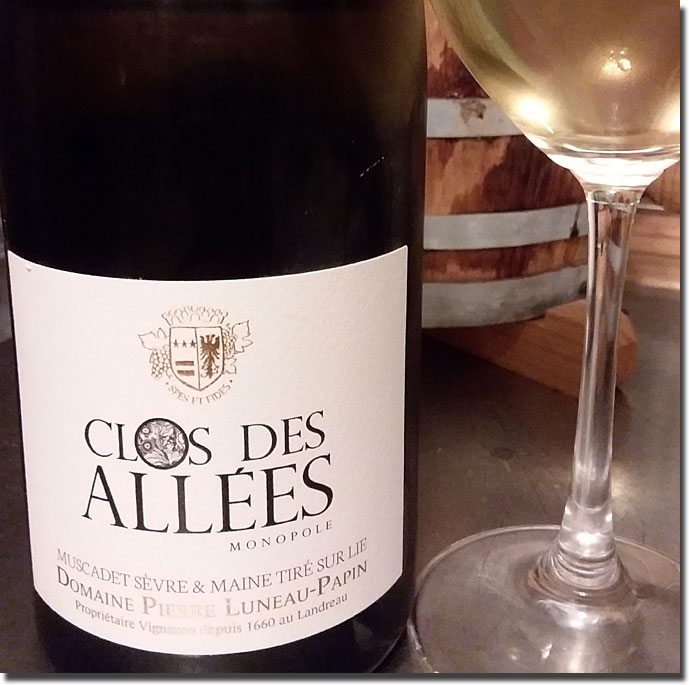 As mentioned in our last report, we stuck to a steady diet of whites from our cellar during the hot summer months, mostly wines that we’ve already reviewed. A few nights ago, I was in the mood for more of the same, and happened upon this little gem, which I’d purchased a few months previous from our friends at Ferndale’s Western Market, cellared and then forgot about. We love pretty much everything from Domaine Luneau-Papin, although the last Clos des Allées we had didn’t show quite as well as we might have hoped. Happily, this one delivers everything we could ever want from a dry white, and the QPR (quality-price ratio) is off the charts. (Click image to enlarge.)
As mentioned in our last report, we stuck to a steady diet of whites from our cellar during the hot summer months, mostly wines that we’ve already reviewed. A few nights ago, I was in the mood for more of the same, and happened upon this little gem, which I’d purchased a few months previous from our friends at Ferndale’s Western Market, cellared and then forgot about. We love pretty much everything from Domaine Luneau-Papin, although the last Clos des Allées we had didn’t show quite as well as we might have hoped. Happily, this one delivers everything we could ever want from a dry white, and the QPR (quality-price ratio) is off the charts. (Click image to enlarge.)
2015 Domaine Pierre Luneau-Papin Muscadet-Sèvre et Maine Sur Lie Clos des Allées, 12% alc., $17.99: I posted this picture on Instagram and Facebook while I was enjoying my first glass, along with this terse description: “Classic Muscadet and then some, from the 2015 vintage. Rich, mineral-driven and bone dry. All that’s missing now is a plate of oysters, and it’ll get even better with more time in the bottle.” To that I would add that the wine shows clean, medium color and offers great depth and intensity of flavor. Medium bodied, with excellent acidity, this does everything one would want from a topnotch Muscadet-Sèvre et Maine Sur Lie. We like this so much that that we made a point of going back and buying another three bottles for now, with an eye to acquiring more later. Highly recommended. Find this wine
Imported by LDM Wines, Inc., New York
Reporting from Day-twah,
Bastardo
Tannat From Troon
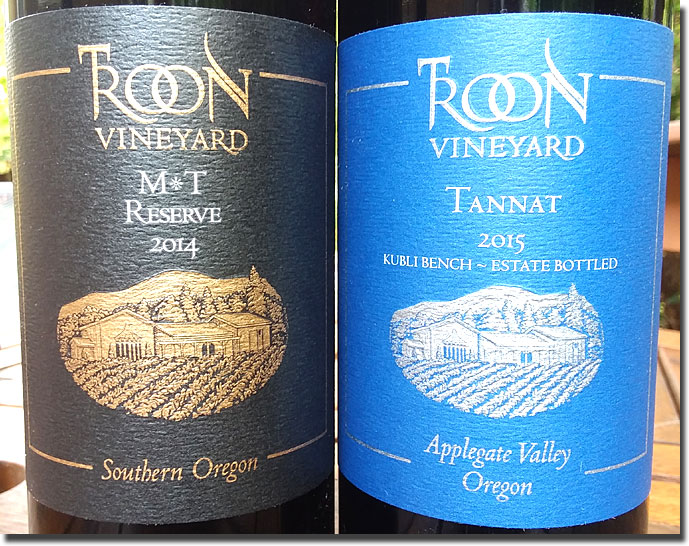 Yeah, I know, it’s been a while since our last report. There are a couple of reasons for this, but the one that really matters is that we’ve mostly been drinking whites from our cellar that we’ve already reviewed; think summer heat and cool and refreshing. However, we did have occasion to try a couple of reds from our friends at Troon Vineyard recently, and as has been the case so often with samples from this rising star from southern Oregon, they are quite impressive. The good news here is that the red grape of Madiran, along with several other seemingly unlikely varietal subjects, thrives in the Applegate Valley. (Click image to enlarge.)
Yeah, I know, it’s been a while since our last report. There are a couple of reasons for this, but the one that really matters is that we’ve mostly been drinking whites from our cellar that we’ve already reviewed; think summer heat and cool and refreshing. However, we did have occasion to try a couple of reds from our friends at Troon Vineyard recently, and as has been the case so often with samples from this rising star from southern Oregon, they are quite impressive. The good news here is that the red grape of Madiran, along with several other seemingly unlikely varietal subjects, thrives in the Applegate Valley. (Click image to enlarge.)
2015 Troon Vineyard Tannat Applegate Valley Kubli Bench Estate Bottled, 96% Tannat, 4% Tempranillo, 14.1% alc., SRP $35: Clean dark color, with a lovely nose of earthy blackberries and black currants, leading into plenty more of the same on the palate; full bodied, nicely balanced and structured for at least 3-5 years of development. Very true to varietal character, based on Madirans we’ve enjoyed in the past, and with extended air, some nice leathery undertones emerge. This drinks quite well already, especially with a grilled, medium rare beef steak. Find this wine
2014 Troon Vineyard MT Applegate Valley Kubli Bench Estate Bottled, 52% Tannat, 46% Malbec, 2% Tempranillo, 14.2% alc., SRP $50: Clean dark color, with expansive aromas of crushed blackberries, black currants and a pretty kiss of sweet oak. Silky smooth on the palate, and a bit more plump and immediately accessible than the Tannat. Flavors echo the nose nicely, and it will also do well with 3-5 years in the cellar, but drinks well already and pairs nicely with the same sliced medium rare beef steak. This will be the last Troon “MT” (tannat/malbec co-ferment); the next vintage will released with a new label and under a new name, “Cuvée Pyrénées,” made in exactly the same manner. Find this wine
These were the last wines bottled under the producer’s old label. New releases will feature a reconceived package designed to better reflect Troon’s mission. As always, Troon General Manager Craig Camp provides plenty of juicy background information on these wines, included here in its entirety.
CC: A key characteristic of granitic soils is that they naturally give softer, rounder tannins, a characteristic you’ll find in all of our estate wines. In our terroir the famed tannins of tannat are tamed, well, somewhat tamed anyway. So while both of these wines exhibit a firm tannic structure, those tannins are more rounded, with no hint of green or bitter tannins. These naturally silky tannins are just one of the reasons we eschew the use of new oak barrels – just one reason as there are many. Laying the tannins from new oak barrels over our naturally generous tannic structure would be… well just stupid. All it would do is bury the character of our vineyard, which we are working very hard to express fully and for this reason we have chosen to practice biodynamic agriculture.
Each of the wines are crafted in the same way. They are crushed by foot and stay overnight in the bins to let the native yeasts get a head start. They are then partially destemmed, but not crushed into small, one ton fermenters. Only hand punch-downs are done, normally once a day, instead of more aggressive pump-overs. Only native yeasts are used and no sugar, acids, enzymes or any additives are used. Fermentation completes in about two weeks and then they are gently pressed and barreled into mature French Oak Burgundy barrels. Malolactic fermentation completes the following spring and the wines rest in barrel for eighteen months. The small amount of tempranillo in the MT is due to the limited amount of tannat and malbec we produce. We decided to use the tempranillo as the topping wine as we felt it would be the most complimentary choice.
Reporting from Day-twah,
Bastardo
Three Sixteen Ridge Zins
Have we ever mentioned how much we love the wines of Ridge Vineyards here at Gang of Pour? No?! I didn’t think so! Haha!!!
So once again, I was ratting around the wine department at Western Market in Ferndale a few weeks ago, and I stopped dead in my tracks when I saw these three. 2016 Zin-types from Ridge?! It was like an alarm or some kind of conditioned response went off in my fevered brain.
Must try!! Must buy!!
And so I did. (Winery prices are listed here. I got these for a little bit less.)
2016 Ridge Vineyards Three Valleys Sonoma County, 68% Zinfandel, 15% Carignane, 12% Petite Sirah, 5% Grenache, 14.3% alc., $30.00: Clean, dark color; a pretty bouquet of black raspberry with a hint of lavender and a kiss of sweet oak echoes and expands on the palate very nicely, with the oak showing a bit more, but by no means to excess. Full bodied, with nice length on the finish; fairly dense, silky smooth in texture, and yet deceptively well structured for 3-5 years in the cellar. Very much in the house style, which translates as de-lish, of course! Find this wine
2016 Ridge Vineyards East Bench Zinfandel, Dry Creek Valley, 14.9% alc., $32.00: Clean and dark in color, with a lovely perfume that could only come from a Ridge Zin. Pretty flavors and aromas of rich black raspberry and blackberry, with a generous kiss of sweet oak and some lavender, blueberry and subtle earth underneath. Elegant, silky smooth and structured to cellar for at least 3-5 years, but so damned good now, why wait?! This one kicks up a notch or three from the Three Valleys, making for an even bigger “yumm” factor. Find this wine
2016 Ridge Vineyards Geyserville Alexander Valley, 73% Zinfandel, 17% Carignane, 7% Petite Sirah, 3% Alicante Bouschet, 73% Zinfandel, 17% Carignane, 7% Petite Sirah, 3% Alicante Bouschet, 14.5% alc., $40.00: Showing clean, dark color, and exuding rich, effusive aromatics that are once again unmistakably Mr. Ridge, all lush dark berry and black cherry, shaded with a little earth and a kiss of oak. A substantial wine, this, full bodied, and typically well-structured for many years of aging and development. Flavors follow through on the promise of the nose, with the earthiness making itself more apparent,and while there’s a ton of fruit here, it will be better with at least 5 years in the cellar, of better yet, 10. It does open nicely in the glass over time, so decant for an hour before drinking now, but it’s better to keep hands off, as patience will certainly be rewarded. Find this wine
These three delights give ample evidence as to why Ridge remains on the very short list of our favorite wineries from anywhere in the world. Period.
Reporting from Day-twah,
Bastardo
Two Troon Italians
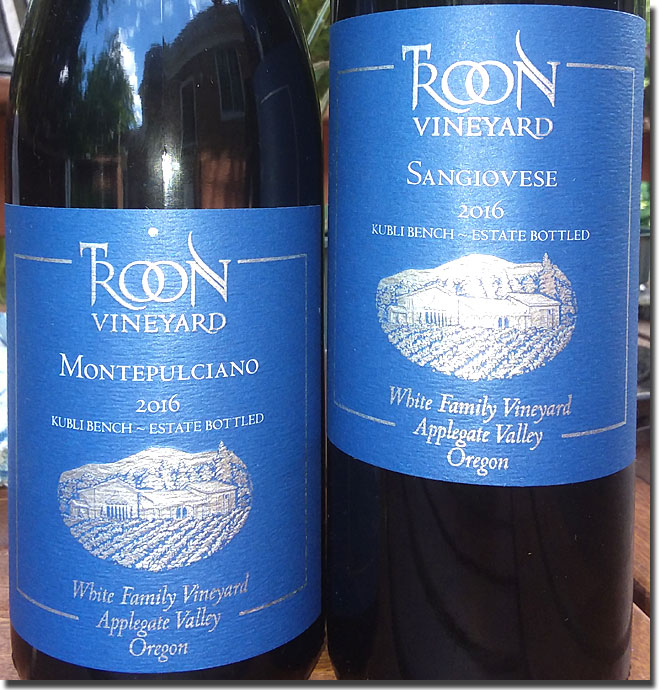 In the past few weeks, we’ve had the opportunity to try a couple of wines from Troon Vineyard that were new to us and made mostly from Italian varieties. As reported previously, this southern Oregon winery is producing exciting bottlings using varieties that you might not expect in that neck of the woods, so we were only too eager to try them and see what they have to offer. We invited our good friends Shar Douglas and Ken Hebenstreit to sample them with us, and Shar offered to make dinner, so we were set to go and in like Flynn.
In the past few weeks, we’ve had the opportunity to try a couple of wines from Troon Vineyard that were new to us and made mostly from Italian varieties. As reported previously, this southern Oregon winery is producing exciting bottlings using varieties that you might not expect in that neck of the woods, so we were only too eager to try them and see what they have to offer. We invited our good friends Shar Douglas and Ken Hebenstreit to sample them with us, and Shar offered to make dinner, so we were set to go and in like Flynn.
2016 Troon Vineyard Montepulciano Applegate Valley Kubli Bench Estate Bottled, 11.5% alc., $25: Clean dark garnet color, with a spicy black cherry nose that carries over on to the palate with a decidedly earthy base. Full bodied and structured for five years or more in the cellar, and while it’s good now with lamb kabobs and rice, it’ll be even better in a few years. Shar added an impression of smoke on the nose; this smoky character does set tone to the wine’s character as it opens, and that’s a good thing. 146 cases produced. Find this wine
2016 Troon Vineyard Sangiovese, Applegate Valley, Kubli Bench Estate Bottled, 12.5% alc., $25: Clean, dark color, with earthy dried cherry and black cherry flavors and aromas. Medium-medium-full bodied, and like the Montepulciano, structured for a good five years or more in the cellar. It opens nicely with a little air, some spicy notes add interest and appeal, and it too makes a good match for the lamb kabobs and rice. “It’s more spicy than the Montepulciano, with less smoke,” adds Shar, and I would agree completely. 194 cases produced. Find this wine
Neither of these two fine reds “wowed” us like several of the French varieties from Troon that we’ve tried, and they aren’t meant to. General Manager Craig Camp describes a “unique touch of bitterness that makes them come alive when paired with a wonderful meal,” as the main reason he’s been enamored with Italian reds for decades, and these both have a bit of that bitterness. Both come off more “Italian” as they continue to open; they are very nice with the meal Shar served and they’re fairly priced for what’s in the bottles. I’m pretty sure that’s exactly what Troon crafted them to do.
Here’s a little background info on these two, as provided by Craig Camp: “Both of these wines are produced from mature vines in our estate vineyards here in the Applegate Valley from the warm 2016 vintage. Both are co-fermented with a small percentage of syrah, which we like to include for a bit of structure and to enhance aromatics. All of the fruit is from our LIVE and Salmon Safe Certified vineyard. Our goal is to achieve our biodynamic certification by 2020.
Each was crafted followed by our established winemaking philosophy, which means crushing by foot followed by native yeast fermentation and hand punch downs in 1 ton fermenters. No acids, sugar, enzymes or additives are used. After fermentation the wines were pressed into mature French Oak Burgundy barrels where they matured for twelve months. No new oak barrels are used.”
Reporting from Day-twah,
Bastardo
The Pink We Drink
I’ve said it before and I’ll say it again; rosé isn’t just a warm weather libation here at Adams-Heritier & Associates, because we drink the stuff the whole year round. Spring IS the time of year when many producers, importers and distributors like to roll out their fresh pink products, and that makes good business sense. We received a nice package from our friends at Tablas Creek Vineyard a few weeks ago, and the hot Memorial Day weekend seemed like the perfect time to twist the Stelvins off of their two rosés and taste what they have to offer. Not surprisingly (we’ve tried several successive vintages now), they did not disappoint in the least.
2017 Tablas Creek Vineyard Patelin de Tablas Rosé Paso Robles, 64% Grenache, 29% Mourvedre, 5% Syrah, 2% Counoise, 13.0% alc., $25.00: Not too pale, and peachy pink in color, with with attractive strawberry and sea air aromatics; straightforward strawberry watermelon flavors shaded with some chalky mineral. Medium bodied, but not lightweight, with good acids and length, and there’s a subtle creamy undertone here in character and texture. Hits all the right buttons for this taster when it comes to dry rosé, so let’s have another glass! 3770 cases produced. Find this wine
2017 Tablas Creek Vineyard Dianthus Paso Robles, 49% Mourvedre, 39% Grenache, 12% Counoise, 14.1% alc., $30.00: This shows an intense strawberry pink color, and while it’s not as generous aromatically as the Patelin, it’s more fruit forward than the paler selection. It’s also a little thicker and more dense than the Patelin; rich and intense, with raspberry, strawberry and cherry characteristics, laced with some mineral. Medium bodied, and maybe a little more, with ample acids and good length. Bold, baby, bold. 1625 cases produced. Find this wine
True to form with previous vintages, the Patelin is more Euro in style, while the Dianthus is more new world, and while I slightly prefer the first for those reasons, both offer plenty of pleasurable drinking. We enjoyed them while reminiscing fondly about our 2010 visit with Jason Haas at Tablas Creek. As we were finishing up our lunch that day, Jason called his father Bob over from an adjacent table and we had a pleasant chat with the venerable founder of Vineyard Brands and co-founder of Tablas Creek. Robert Haas passed away on March 18 at his home in Paso Robles. We drank a toast to his life, his illustrious career and his many achievements.
Reporting from Day-twah,
Bastardo




